Abstract
Acclimatisation to environmental hypoxia initiates a series of metabolic and musculocardio-respiratory adaptations that influence oxygen transport and utilisation, or better still, being born and raised at altitude, is necessary to achieve optimal physical performance at altitude, scientific evidence to support the potentiating effects after return to sea level is at present equivocal. Despite this, elite athletes continue to spend considerable time and resources training at altitude, misled by subjective coaching opinion and the inconclusive findings of a large number of uncontrolled studies. Scientific investigation has focused on the optimisation of the theoretically beneficial aspects of altitude acclimatisation, which include increases in blood haemoglobin concentration, elevated buffering capacity, and improvements in the structural and biochemical properties of skeletal muscle. However, not all aspects of altitude acclimatisation are beneficial; cardiac output and blood flow to skeletal muscles decrease, and preliminary evidence has shown that hypoxia in itself is responsible for a depression of immune function and increased tissue damage mediated by oxidative stress. Future research needs to focus on these less beneficial aspects of altitude training, the implications of which pose a threat to both the fitness and the health of the elite competitor. Paul Bert was the first investigator to show that acclimatisation to a chronically reduced inspiratory partial pressure of oxygen (P1O2) invoked a series of central and peripheral adaptations that served to maintain adequate tissue oxygenation in healthy skeletal muscle, physiological adaptations that have been subsequently implicated in the improvement in exercise performance during altitude acclimatisation. However, it was not until half a century later that scientists suggested that the additive stimulus of environmental hypoxia could potentially compound the normal physiological adaptations to endurance training and accelerate performance improvements after return to sea level. This has stimulated an exponential increase in scientific research, and, since 1984, 22 major reviews have summarised the physiological implications of altitude training for both aerobic and anaerobic performance at altitude and after return to sea level. Of these reviews, only eight have specifically focused on physical performance changes after return to sea level, the most comprehensive of which was recently written by Wolski et al. Few reviews have considered the potentially less favourable physiological responses to moderate altitude exposure, which include decreases in absolute training intensity, decreased plasma volume, depression of haemopoiesis and increased haemolysis, increases in sympathetically mediated glycogen depletion at altitude, and increased respiratory muscle work after return to sea level. In addition, there is a risk of developing more serious medical complications at altitude, which include acute mountain sickness, pulmonary oedema, cardiac arrhythmias, and cerebral hypoxia. The possible implications of changes in immune function at altitude have also been largely ignored, despite accumulating evidence of hypoxia mediated immunosuppression. In general, altitude training has been shown to improve performance at altitude, whereas no unequivocal evidence exists to support the claim that performance at sea level is improved. Table 1 summarises the theoretical advantages and disadvantages of altitude training for sea level performance. This review summarises the physiological rationale for altitude training as a means of enhancing endurance performance after return to sea level. Factors that have been shown to affect the acclimatisation process and the subsequent implications for exercise performance at sea level will also be discussed. Studies were located using five major database searches, which included Medline, Embase, Science Citation Index, Sports Discus, and Sport, in
Full text
PDF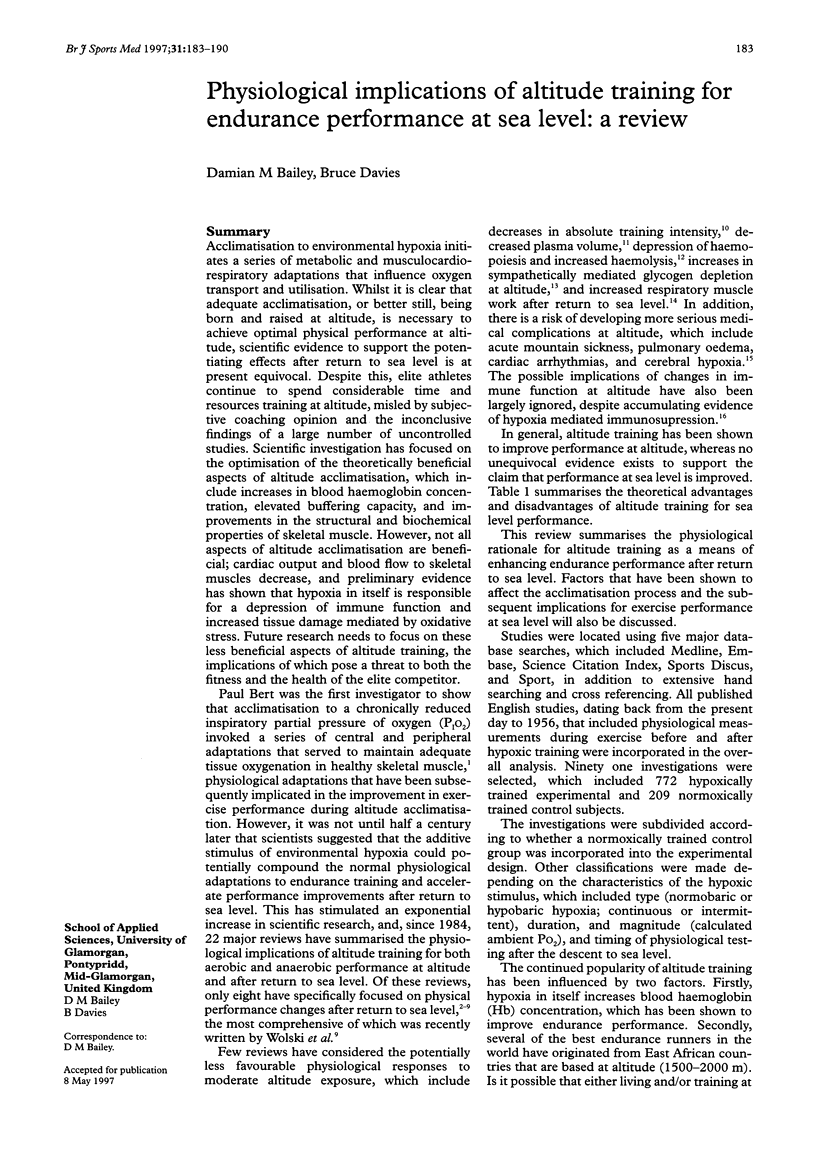
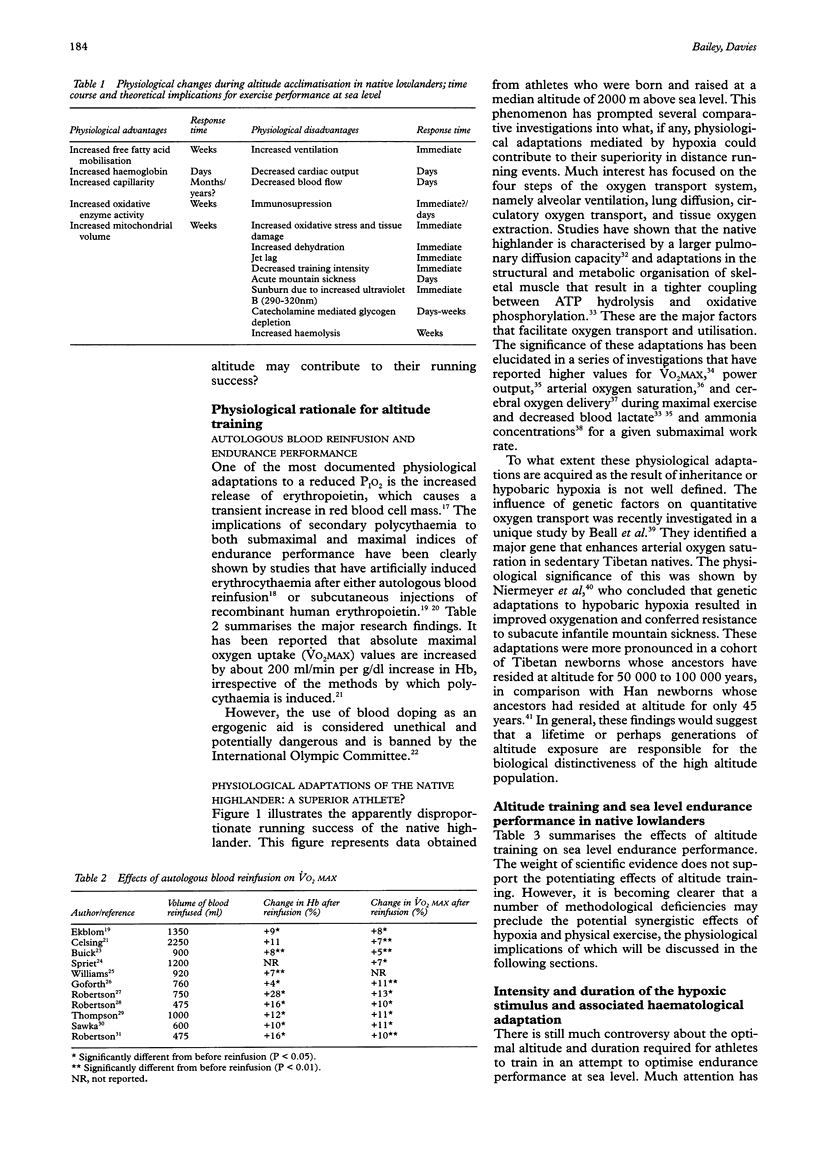
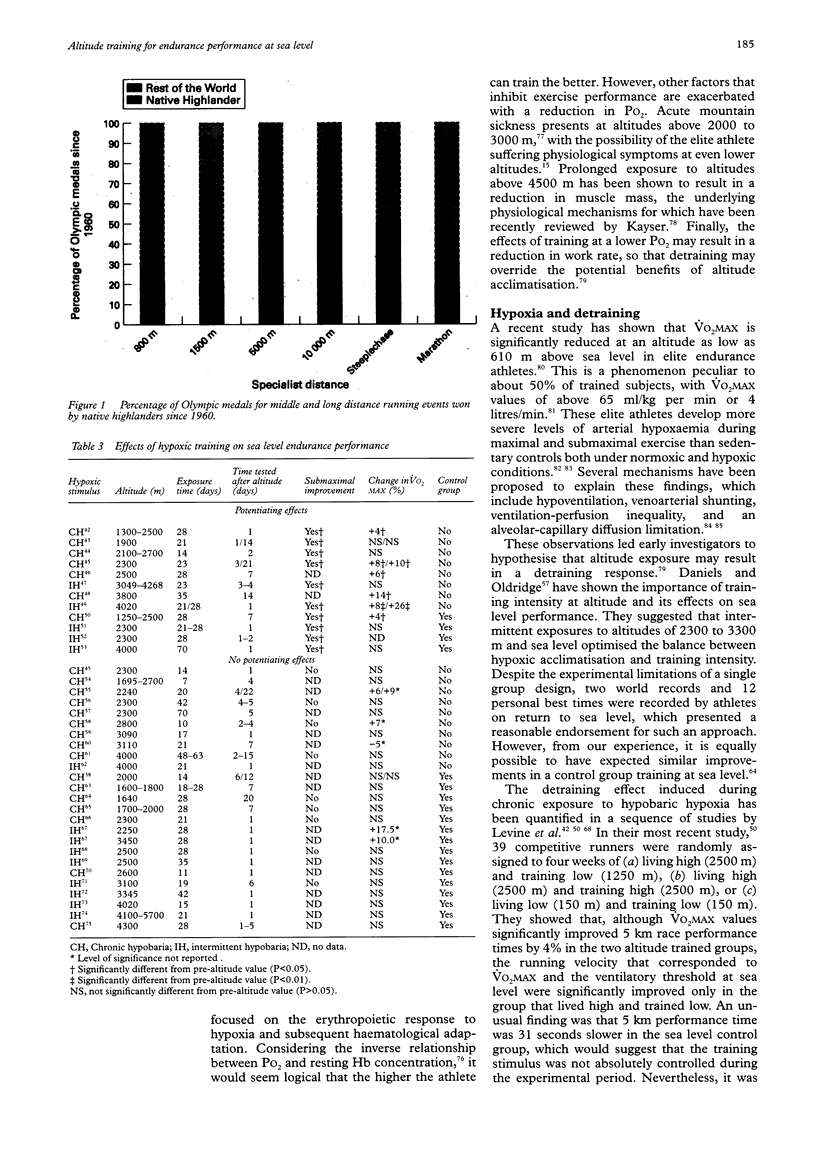
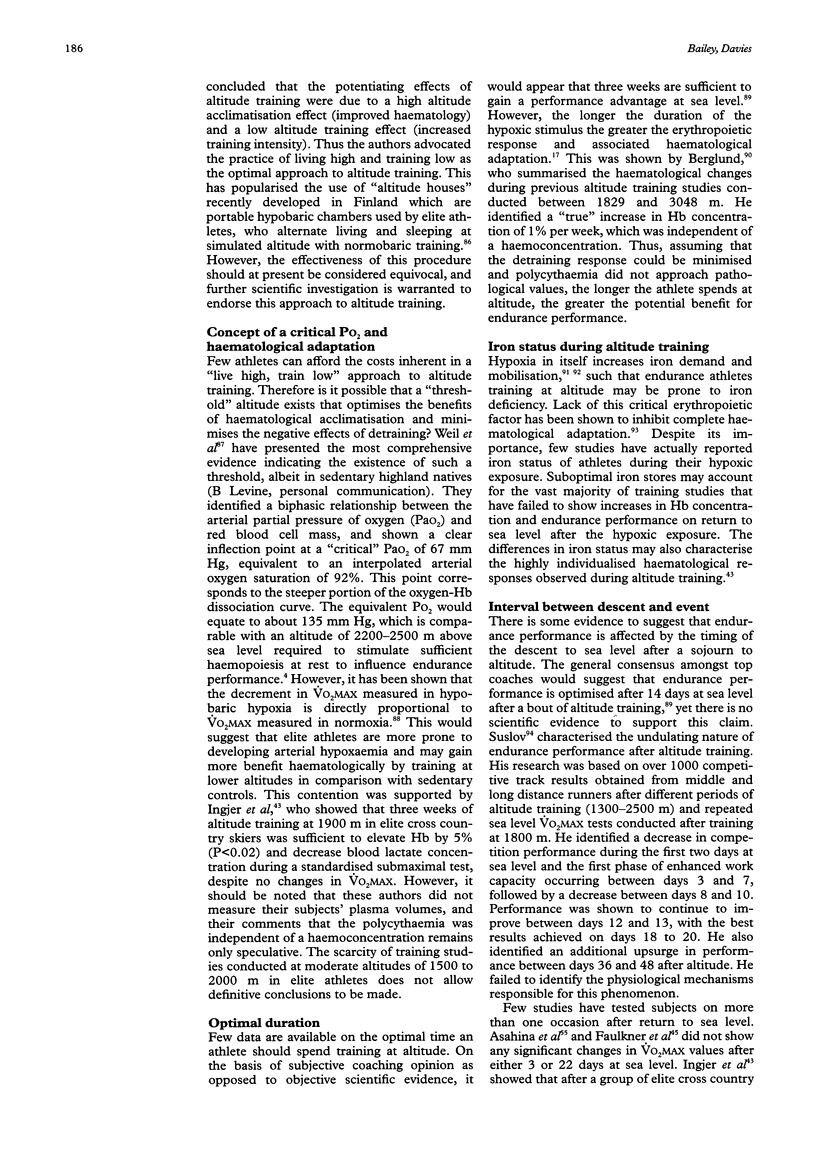
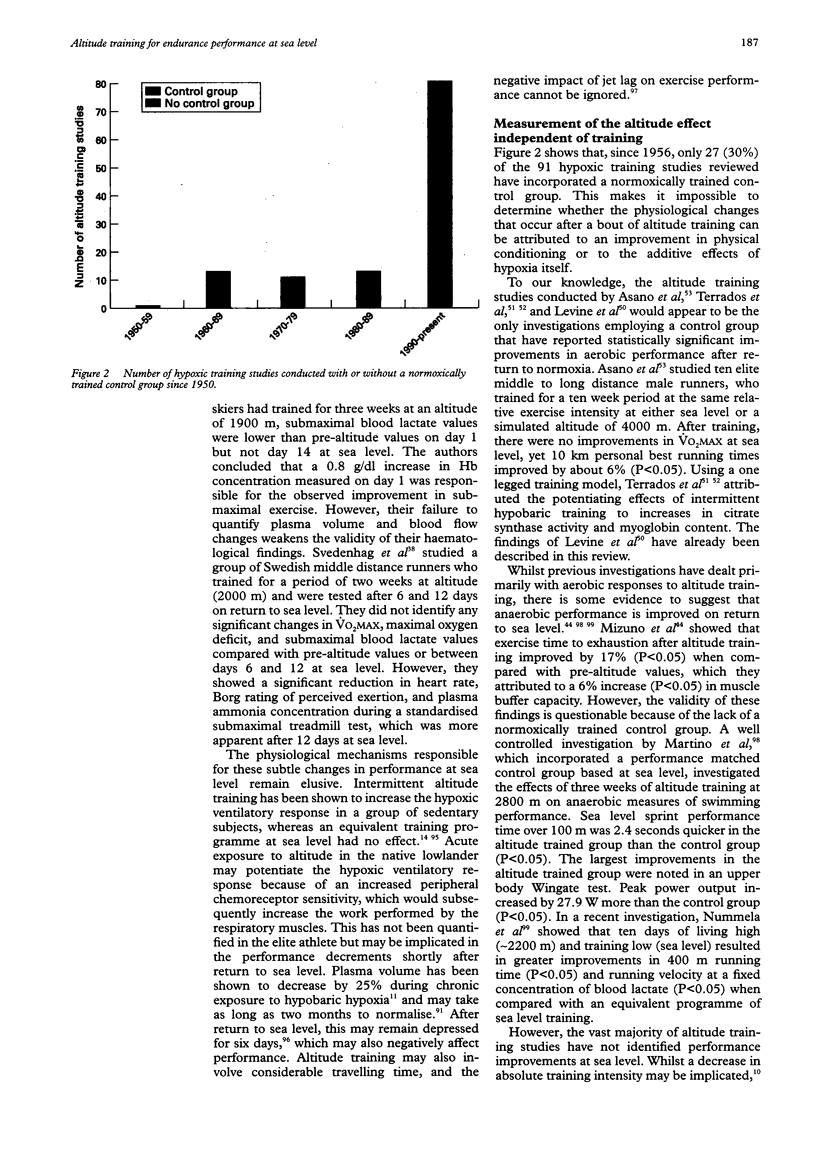
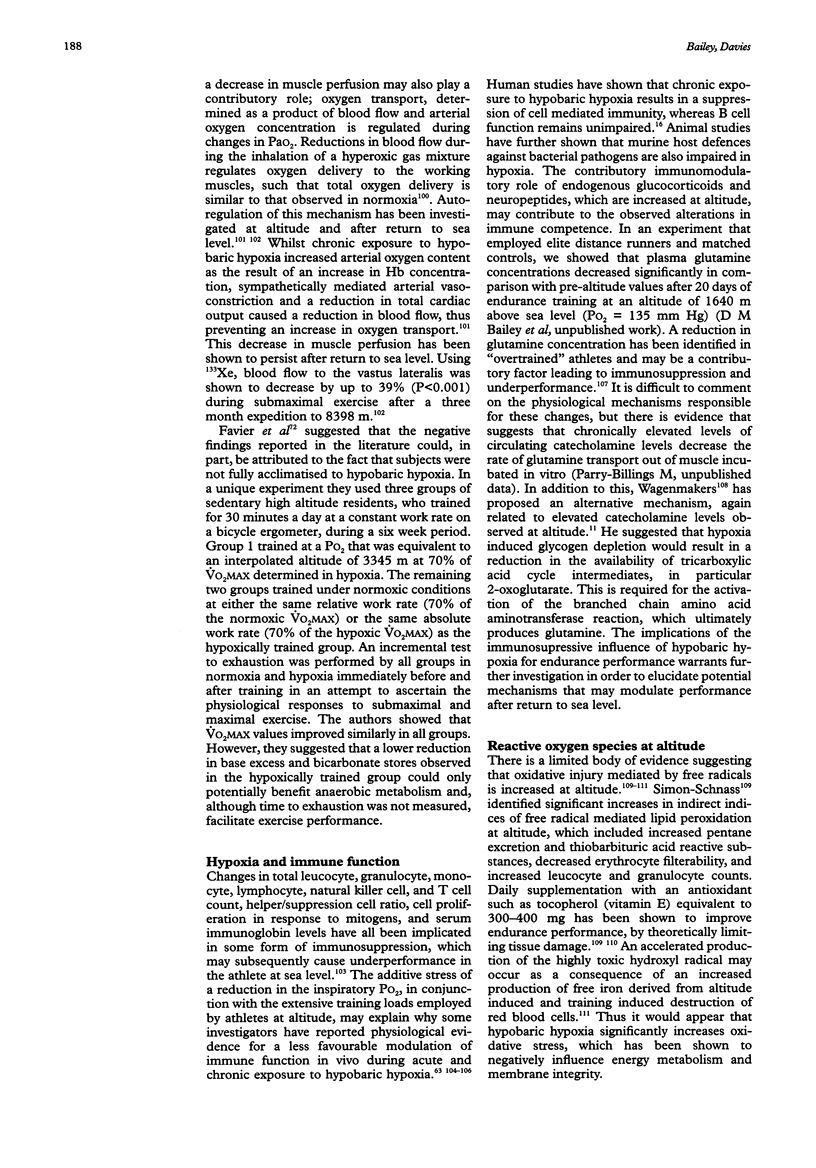
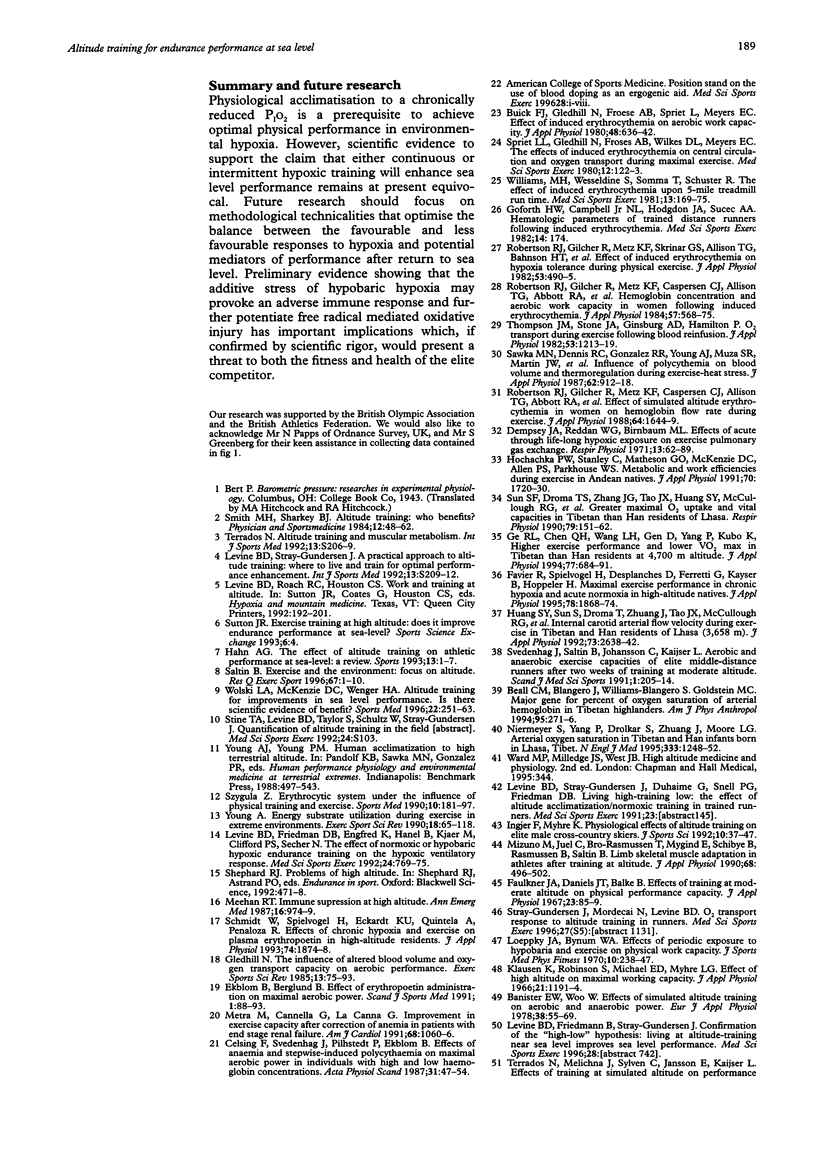
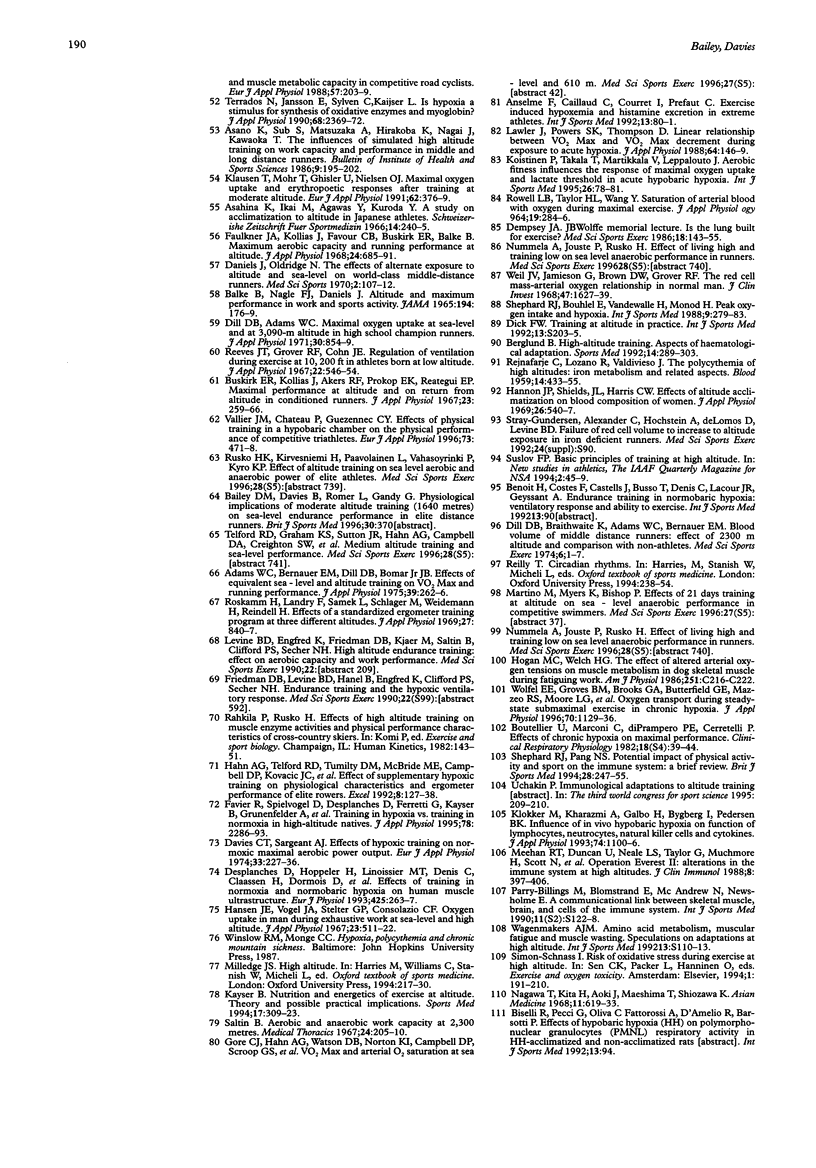
Images in this article
Selected References
These references are in PubMed. This may not be the complete list of references from this article.
- Adams W. C., Bernauer E. M., Dill D. B., Bomar J. B., Jr Effects of equivalent sea-level and altitude training on VO2max and running performance. J Appl Physiol. 1975 Aug;39(2):262–266. doi: 10.1152/jappl.1975.39.2.262. [DOI] [PubMed] [Google Scholar]
- Beall C. M., Blangero J., Williams-Blangero S., Goldstein M. C. Major gene for percent of oxygen saturation of arterial hemoglobin in Tibetan highlanders. Am J Phys Anthropol. 1994 Nov;95(3):271–276. doi: 10.1002/ajpa.1330950303. [DOI] [PubMed] [Google Scholar]
- Berglund B. High-altitude training. Aspects of haematological adaptation. Sports Med. 1992 Nov;14(5):289–303. doi: 10.2165/00007256-199214050-00002. [DOI] [PubMed] [Google Scholar]
- Buick F. J., Gledhill N., Froese A. B., Spriet L., Meyers E. C. Effect of induced erythrocythemia on aerobic work capacity. J Appl Physiol Respir Environ Exerc Physiol. 1980 Apr;48(4):636–642. doi: 10.1152/jappl.1980.48.4.636. [DOI] [PubMed] [Google Scholar]
- Buskirk E. R., Kollias J., Akers R. F., Prokop E. K., Reategui E. P. Maximal performance at altitude and on return from altitude in conditioned runners. J Appl Physiol. 1967 Aug;23(2):259–266. doi: 10.1152/jappl.1967.23.2.259. [DOI] [PubMed] [Google Scholar]
- Celsing F., Svedenhag J., Pihlstedt P., Ekblom B. Effects of anaemia and stepwise-induced polycythaemia on maximal aerobic power in individuals with high and low haemoglobin concentrations. Acta Physiol Scand. 1987 Jan;129(1):47–54. doi: 10.1111/j.1748-1716.1987.tb08038.x. [DOI] [PubMed] [Google Scholar]
- Daniels J., Oldridge N. The effects of alternate exposure to altitude and sea level on world-class middle-distance runners. Med Sci Sports. 1970 Fall;2(3):107–112. [PubMed] [Google Scholar]
- Davies C. T., Sargeant A. J. Effects of hypoxic training on normoxic maximal aerobic power output. Eur J Appl Physiol Occup Physiol. 1974;33(3):227–236. doi: 10.1007/BF00421150. [DOI] [PubMed] [Google Scholar]
- Dempsey J. A. J.B. Wolffe memorial lecture. Is the lung built for exercise? Med Sci Sports Exerc. 1986 Apr;18(2):143–155. [PubMed] [Google Scholar]
- Desplanches D., Hoppeler H., Linossier M. T., Denis C., Claassen H., Dormois D., Lacour J. R., Geyssant A. Effects of training in normoxia and normobaric hypoxia on human muscle ultrastructure. Pflugers Arch. 1993 Nov;425(3-4):263–267. doi: 10.1007/BF00374176. [DOI] [PubMed] [Google Scholar]
- Dick F. W. Training at altitude in practice. Int J Sports Med. 1992 Oct;13 (Suppl 1):S203–S206. doi: 10.1055/s-2007-1024640. [DOI] [PubMed] [Google Scholar]
- Dill D. B., Adams W. C. Maximal oxygen uptake at sea level and at 3,090-m altitude in high school champion runners. J Appl Physiol. 1971 Jun;30(6):854–859. doi: 10.1152/jappl.1971.30.6.854. [DOI] [PubMed] [Google Scholar]
- Faulkner J. A., Daniels J. T., Balke B. Effects of training at moderate altitude on physical performance capacity. J Appl Physiol. 1967 Jul;23(1):85–89. doi: 10.1152/jappl.1967.23.1.85. [DOI] [PubMed] [Google Scholar]
- Faulkner J. A., Kollias J., Favour C. B., Buskirk E. R., Balke B. Maximum aerobic capacity and running performance at altitude. J Appl Physiol. 1968 May;24(5):685–691. doi: 10.1152/jappl.1968.24.5.685. [DOI] [PubMed] [Google Scholar]
- Favier R., Spielvogel H., Desplanches D., Ferretti G., Kayser B., Grünenfelder A., Leuenberger M., Tüscher L., Caceres E., Hoppeler H. Training in hypoxia vs. training in normoxia in high-altitude natives. J Appl Physiol (1985) 1995 Jun;78(6):2286–2293. doi: 10.1152/jappl.1995.78.6.2286. [DOI] [PubMed] [Google Scholar]
- Favier R., Spielvogel H., Desplanches D., Ferretti G., Kayser B., Hoppeler H. Maximal exercise performance in chronic hypoxia and acute normoxia in high-altitude natives. J Appl Physiol (1985) 1995 May;78(5):1868–1874. doi: 10.1152/jappl.1995.78.5.1868. [DOI] [PubMed] [Google Scholar]
- Ge R. L., Chen Q. H., Wang L. H., Gen D., Yang P., Kubo K., Fujimoto K., Matsuzawa Y., Yoshimura K., Takeoka M. Higher exercise performance and lower VO2max in Tibetan than Han residents at 4,700 m altitude. J Appl Physiol (1985) 1994 Aug;77(2):684–691. doi: 10.1152/jappl.1994.77.2.684. [DOI] [PubMed] [Google Scholar]
- Gledhill N. The influence of altered blood volume and oxygen transport capacity on aerobic performance. Exerc Sport Sci Rev. 1985;13:75–93. [PubMed] [Google Scholar]
- Hannon J. P., Shields J. L., Harris C. W. Effects of altitude acclimatization on blood composition of women. J Appl Physiol. 1969 May;26(5):540–547. doi: 10.1152/jappl.1969.26.5.540. [DOI] [PubMed] [Google Scholar]
- Hansen J. E., Vogel J. A., Stelter G. P., Consolazio C. F. Oxygen uptake in man during exhaustive work at sea level and high altitude. J Appl Physiol. 1967 Oct;23(4):511–522. doi: 10.1152/jappl.1967.23.4.511. [DOI] [PubMed] [Google Scholar]
- Hochachka P. W., Stanley C., Matheson G. O., McKenzie D. C., Allen P. S., Parkhouse W. S. Metabolic and work efficiencies during exercise in Andean natives. J Appl Physiol (1985) 1991 Apr;70(4):1720–1730. doi: 10.1152/jappl.1991.70.4.1720. [DOI] [PubMed] [Google Scholar]
- Hogan M. C., Welch H. G. Effect of altered arterial O2 tensions on muscle metabolism in dog skeletal muscle during fatiguing work. Am J Physiol. 1986 Aug;251(2 Pt 1):C216–C222. doi: 10.1152/ajpcell.1986.251.2.C216. [DOI] [PubMed] [Google Scholar]
- Huang S. Y., Sun S., Droma T., Zhuang J., Tao J. X., McCullough R. G., McCullough R. E., Micco A. J., Reeves J. T., Moore L. G. Internal carotid arterial flow velocity during exercise in Tibetan and Han residents of Lhasa (3,658 m). J Appl Physiol (1985) 1992 Dec;73(6):2638–2642. doi: 10.1152/jappl.1992.73.6.2638. [DOI] [PubMed] [Google Scholar]
- Ingjer F., Myhre K. Physiological effects of altitude training on elite male cross-country skiers. J Sports Sci. 1992 Feb;10(1):37–47. doi: 10.1080/02640419208729905. [DOI] [PubMed] [Google Scholar]
- Kayser B. Nutrition and energetics of exercise at altitude. Theory and possible practical implications. Sports Med. 1994 May;17(5):309–323. doi: 10.2165/00007256-199417050-00004. [DOI] [PubMed] [Google Scholar]
- Klausen K., Robinson S., Micahel E. D., Myhre L. G. Effect of high altitude on maximal working capacity. J Appl Physiol. 1966 Jul;21(4):1191–1194. doi: 10.1152/jappl.1966.21.4.1191. [DOI] [PubMed] [Google Scholar]
- Klokker M., Kharazmi A., Galbo H., Bygbjerg I., Pedersen B. K. Influence of in vivo hypobaric hypoxia on function of lymphocytes, neutrocytes, natural killer cells, and cytokines. J Appl Physiol (1985) 1993 Mar;74(3):1100–1106. doi: 10.1152/jappl.1993.74.3.1100. [DOI] [PubMed] [Google Scholar]
- Koistinen P., Takala T., Martikkala V., Leppäluoto J. Aerobic fitness influences the response of maximal oxygen uptake and lactate threshold in acute hypobaric hypoxia. Int J Sports Med. 1995 Feb;16(2):78–81. doi: 10.1055/s-2007-972968. [DOI] [PubMed] [Google Scholar]
- Levine B. D., Friedman D. B., Engfred K., Hanel B., Kjaer M., Clifford P. S., Secher N. H. The effect of normoxic or hypobaric hypoxic endurance training on the hypoxic ventilatory response. Med Sci Sports Exerc. 1992 Jul;24(7):769–775. [PubMed] [Google Scholar]
- Levine B. D., Stray-Gundersen J. A practical approach to altitude training: where to live and train for optimal performance enhancement. Int J Sports Med. 1992 Oct;13 (Suppl 1):S209–S212. doi: 10.1055/s-2007-1024642. [DOI] [PubMed] [Google Scholar]
- Loeppky J. A., Bynum W. A. Effects of periodic exposure to hypobaria and exercise on physical work capacity. J Sports Med Phys Fitness. 1970 Dec;10(4):238–247. [PubMed] [Google Scholar]
- Meehan R. T. Immune suppression at high altitude. Ann Emerg Med. 1987 Sep;16(9):974–979. doi: 10.1016/s0196-0644(87)80743-6. [DOI] [PubMed] [Google Scholar]
- Meehan R., Duncan U., Neale L., Taylor G., Muchmore H., Scott N., Ramsey K., Smith E., Rock P., Goldblum R. Operation Everest II: alterations in the immune system at high altitudes. J Clin Immunol. 1988 Sep;8(5):397–406. doi: 10.1007/BF00917156. [DOI] [PubMed] [Google Scholar]
- Metra M., Cannella G., La Canna G., Guaini T., Sandrini M., Gaggiotti M., Movilli E., Dei Cas L. Improvement in exercise capacity after correction of anemia in patients with end-stage renal failure. Am J Cardiol. 1991 Oct 15;68(10):1060–1066. doi: 10.1016/0002-9149(91)90496-8. [DOI] [PubMed] [Google Scholar]
- Mizuno M., Juel C., Bro-Rasmussen T., Mygind E., Schibye B., Rasmussen B., Saltin B. Limb skeletal muscle adaptation in athletes after training at altitude. J Appl Physiol (1985) 1990 Feb;68(2):496–502. doi: 10.1152/jappl.1990.68.2.496. [DOI] [PubMed] [Google Scholar]
- Niermeyer S., Yang P., Shanmina, Drolkar, Zhuang J., Moore L. G. Arterial oxygen saturation in Tibetan and Han infants born in Lhasa, Tibet. N Engl J Med. 1995 Nov 9;333(19):1248–1252. doi: 10.1056/NEJM199511093331903. [DOI] [PubMed] [Google Scholar]
- Parry-Billings M., Blomstrand E., McAndrew N., Newsholme E. A. A communicational link between skeletal muscle, brain, and cells of the immune system. Int J Sports Med. 1990 May;11 (Suppl 2):S122–S128. doi: 10.1055/s-2007-1024863. [DOI] [PubMed] [Google Scholar]
- REYNAFARJE C., LOZANO R., VALDIVIESO J. The polycythemia of high altitudes: iron metabolism and related aspects. Blood. 1959 Apr;14(4):433–455. [PubMed] [Google Scholar]
- Reeves J. T., Grover R. F., Cohn J. E. Regulation of ventilation during exercise at 10,200 ft in athletes born at low altitude. J Appl Physiol. 1967 Mar;22(3):546–554. doi: 10.1152/jappl.1967.22.3.546. [DOI] [PubMed] [Google Scholar]
- Robertson R. J., Gilcher R., Metz K. F., Caspersen C. J., Allison T. G., Abbott R. A., Skrinar G. S., Krause J. R., Nixon P. A. Effect of simulated altitude erythrocythemia in women on hemoglobin flow rate during exercise. J Appl Physiol (1985) 1988 Apr;64(4):1644–1649. doi: 10.1152/jappl.1988.64.4.1644. [DOI] [PubMed] [Google Scholar]
- Robertson R. J., Gilcher R., Metz K. F., Caspersen C. J., Allison T. G., Abbott R. A., Skrinar G. S., Krause J. R., Nixon P. A. Hemoglobin concentration and aerobic work capacity in women following induced erythrocythemia. J Appl Physiol Respir Environ Exerc Physiol. 1984 Aug;57(2):568–575. doi: 10.1152/jappl.1984.57.2.568. [DOI] [PubMed] [Google Scholar]
- Robertson R. J., Gilcher R., Metz K. F., Skrinar G. S., Allison T. G., Bahnson H. T., Abbott R. A., Becker R., Falkel J. E. Effect of induced erythrocythemia on hypoxia tolerance during physical exercise. J Appl Physiol Respir Environ Exerc Physiol. 1982 Aug;53(2):490–495. doi: 10.1152/jappl.1982.53.2.490. [DOI] [PubMed] [Google Scholar]
- Roskamm H., Landry F., Samek L., Schlager M., Weidemann H., Reindell H. Effects of a standardized ergometer training program at three different altitudes. J Appl Physiol. 1969 Dec;27(6):840–847. doi: 10.1152/jappl.1969.27.6.840. [DOI] [PubMed] [Google Scholar]
- Saltin B. Exercise and the environment: focus on altitude. Res Q Exerc Sport. 1996 Sep;67(3 Suppl):S1–10. doi: 10.1080/02701367.1996.10608849. [DOI] [PubMed] [Google Scholar]
- Sawka M. N., Dennis R. C., Gonzalez R. R., Young A. J., Muza S. R., Martin J. W., Wenger C. B., Francesconi R. P., Pandolf K. B., Valeri C. R. Influence of polycythemia on blood volume and thermoregulation during exercise-heat stress. J Appl Physiol (1985) 1987 Mar;62(3):912–918. doi: 10.1152/jappl.1987.62.3.912. [DOI] [PubMed] [Google Scholar]
- Schmidt W., Spielvogel H., Eckardt K. U., Quintela A., Peñaloza R. Effects of chronic hypoxia and exercise on plasma erythropoietin in high-altitude residents. J Appl Physiol (1985) 1993 Apr;74(4):1874–1878. doi: 10.1152/jappl.1993.74.4.1874. [DOI] [PubMed] [Google Scholar]
- Shephard R. J., Bouhlel E., Vandewalle H., Monod H. Peak oxygen intake and hypoxia: influence of physical fitness. Int J Sports Med. 1988 Aug;9(4):279–283. doi: 10.1055/s-2007-1025022. [DOI] [PubMed] [Google Scholar]
- Shephard R. J., Shek P. N. Potential impact of physical activity and sport on the immune system--a brief review. Br J Sports Med. 1994 Dec;28(4):247–255. doi: 10.1136/bjsm.28.4.247. [DOI] [PMC free article] [PubMed] [Google Scholar]
- Sun S. F., Droma T. S., Zhang J. G., Tao J. X., Huang S. Y., McCullough R. G., McCullough R. E., Reeves C. S., Reeves J. T., Moore L. G. Greater maximal O2 uptakes and vital capacities in Tibetan than Han residents of Lhasa. Respir Physiol. 1990 Feb;79(2):151–161. doi: 10.1016/0034-5687(90)90015-q. [DOI] [PubMed] [Google Scholar]
- Szygula Z. Erythrocytic system under the influence of physical exercise and training. Sports Med. 1990 Sep;10(3):181–197. doi: 10.2165/00007256-199010030-00004. [DOI] [PubMed] [Google Scholar]
- Terrados N. Altitude training and muscular metabolism. Int J Sports Med. 1992 Oct;13 (Suppl 1):S206–S209. doi: 10.1055/s-2007-1024641. [DOI] [PubMed] [Google Scholar]
- Terrados N., Jansson E., Sylvén C., Kaijser L. Is hypoxia a stimulus for synthesis of oxidative enzymes and myoglobin? J Appl Physiol (1985) 1990 Jun;68(6):2369–2372. doi: 10.1152/jappl.1990.68.6.2369. [DOI] [PubMed] [Google Scholar]
- Terrados N., Melichna J., Sylvén C., Jansson E., Kaijser L. Effects of training at simulated altitude on performance and muscle metabolic capacity in competitive road cyclists. Eur J Appl Physiol Occup Physiol. 1988;57(2):203–209. doi: 10.1007/BF00640664. [DOI] [PubMed] [Google Scholar]
- Thomson J. M., Stone J. A., Ginsburg A. D., Hamilton P. O2 transport during exercise following blood reinfusion. J Appl Physiol Respir Environ Exerc Physiol. 1982 Nov;53(5):1213–1219. doi: 10.1152/jappl.1982.53.5.1213. [DOI] [PubMed] [Google Scholar]
- Vallier J. M., Chateau P., Guezennec C. Y. Effects of physical training in a hypobaric chamber on the physical performance of competitive triathletes. Eur J Appl Physiol Occup Physiol. 1996;73(5):471–478. doi: 10.1007/BF00334426. [DOI] [PubMed] [Google Scholar]
- Weil J. V., Jamieson G., Brown D. W., Grover R. F. The red cell mass--arterial oxygen relationship in normal man. Application to patients with chronic obstructive airway disease. J Clin Invest. 1968 Jul;47(7):1627–1639. doi: 10.1172/JCI105854. [DOI] [PMC free article] [PubMed] [Google Scholar]
- Williams M. H., Wesseldine S., Somma T., Schuster R. The effect of induced erythrocythemia upon 5-mile treadmill run time. Med Sci Sports Exerc. 1981;13(3):169–175. [PubMed] [Google Scholar]
- Wolfel E. E., Groves B. M., Brooks G. A., Butterfield G. E., Mazzeo R. S., Moore L. G., Sutton J. R., Bender P. R., Dahms T. E., McCullough R. E. Oxygen transport during steady-state submaximal exercise in chronic hypoxia. J Appl Physiol (1985) 1991 Mar;70(3):1129–1136. doi: 10.1152/jappl.1991.70.3.1129. [DOI] [PubMed] [Google Scholar]
- Wolski L. A., McKenzie D. C., Wenger H. A. Altitude training for improvements in sea level performance. Is the scientific evidence of benefit? Sports Med. 1996 Oct;22(4):251–263. doi: 10.2165/00007256-199622040-00004. [DOI] [PubMed] [Google Scholar]
- Young A. J. Energy substrate utilization during exercise in extreme environments. Exerc Sport Sci Rev. 1990;18:65–117. [PubMed] [Google Scholar]
- de Swiniarski R., Mataamé M., Tanche M. Plethysmography study and pulmonary function in well-trained adolescents. Bull Eur Physiopathol Respir. 1982 Jan-Feb;18(1):39–49. [PubMed] [Google Scholar]




